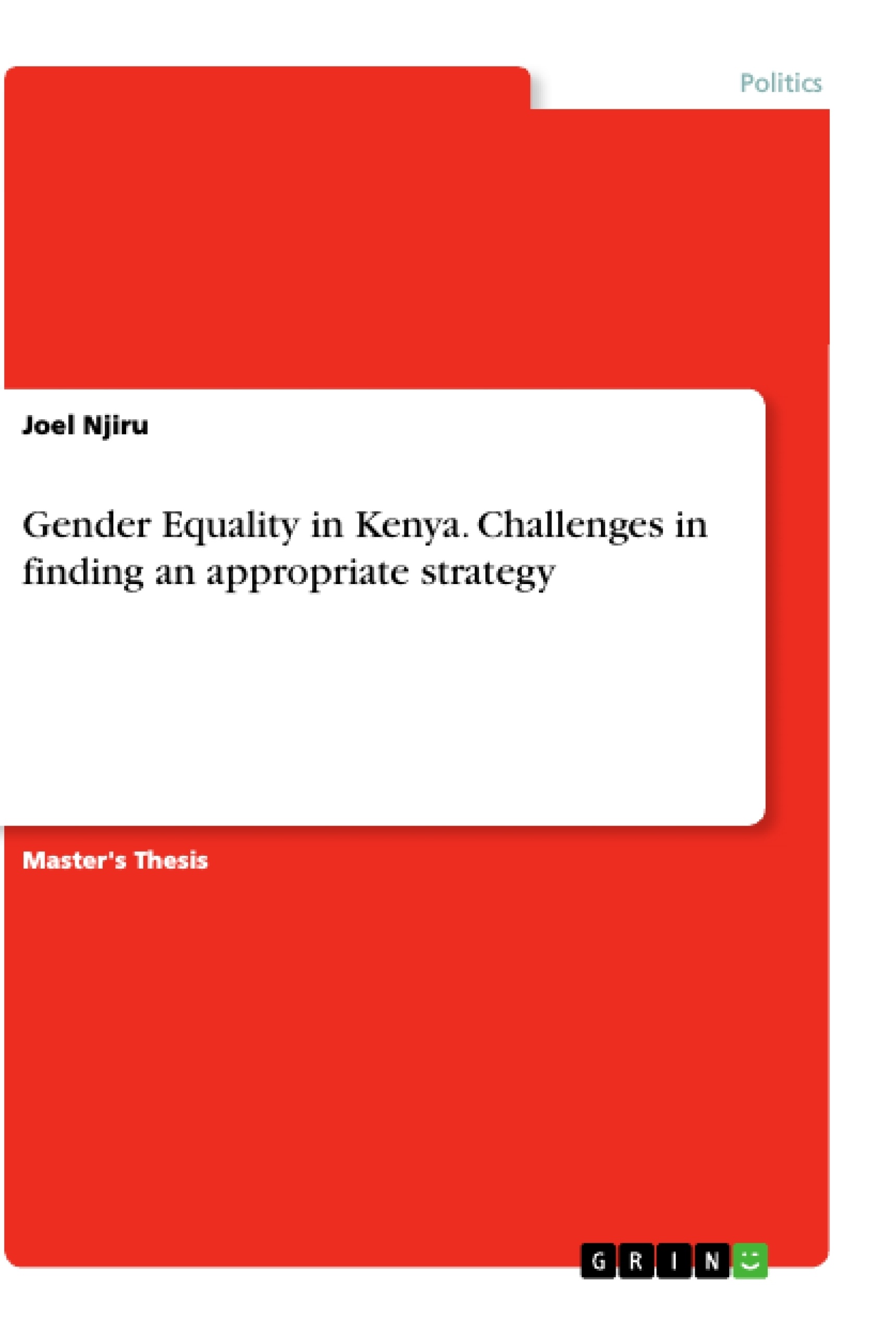Gender inequality in Kenya is real. The problem of gender inequality still prevails in almost all spheres of life despite the many efforts by the government to try to achieve gender parity in all spheres. The major reason why this situation has prevailed is due to the complexity of the concept of gender equality and the fact that it has received minimal attention. Gender equality should go beyond being perceived as ‘sameness’. In reality, majority of the Kenyan women and girls are facing the problem of inequality and discrimination.
This paper tries to evaluate the efforts made by the Kenyan government in achieving gender equality. In addition, it seeks to look at the gaps that the government has left out leading to the current situation where there exist educational disparities, social, cultural and economic. It will also look at the efforts by the non-governmental organizations (NGOs) in bringing gender parity. Lastly, this paper proposes several interventions that need to be put in place in order to achieve gender equality.
Inhaltsverzeichnis (Table of Contents)
- Abstract
- Acknowledgement
- Table of contents
- List of figures and tables
- Acronyms and abbreviations
- Map of Kenya
- CHAPTER ONE
- 1.0 INTRODUCTION
- 1.1 Background
- 1.2 Problem Statement
- 1.3 Contextual Theories and Frameworks
- 1.4 Study objectives
- 1.5 Significance of the study
- 1.6 Chapter summary
- CHAPTER TWO
- 2.0 METHODOLOGY
- 2.1 Introduction
- 2.2 Research design
- 2.3 Study population
- 2.4 Data collection
- 2.5 Chapter summary
- CHAPTER THREE
- 3.0 FINDINGS
- 3.1 Introduction
- 3.2 Factors affecting gender equality in Kenya
- 3.2.1 Education sector
- 3.2.2 Employment sector
- 3.2.3 Gender Roles in Society and School Participation
- 3.2.4 Gender Based Violence (GBV)
- 3.2.5 Female Genital Mutilation (FGM)
- 3.3 Kenyan government progress towards SDG #5
- 3.3.1 Prohibition of Female Genital Mutilation Act
- 3.3.2 The New Constitution
- 3.3.3 The National Gender Equality Commission
- 3.3.4 The Women Enterprise Fund (WEF)
- 3.3.5 Enactment of legislations and policies
- 3.4 Role played by men in gender equality
- 3.5 Role played by the non-governmental organizations
- 3.5.1 Gender based violence programs
- 3.5.2 Prevention of sexual exploitation
- 3.5.3 Menstrual hygiene programs
- 3.5.3 Employment opportunities for women
- 3.5.4 Women in Power and Decision-making
- 3.5.5 Human rights and women
- 3.6 How Kenya compares with her neighbors on gender issues
- 3.7 Chapter summary
- CHAPTER FOUR
- 4.0 DISCUSSIONS AND CONCLUSION
- 4.1 Introduction
- 4.2 Analysis of the state of the Kenyan girl child and women through the CST and IHD lens
- 4.2.1 The dignity of the human person
- 4.2.2 Community Participation
- 4.2.3 Rights and Responsibility
- 4.2.4 Option for the poor
- 4.2.5 Solidarity
- 4.3 Recommendations
Zielsetzung und Themenschwerpunkte (Objectives and Key Themes)
This capstone project examines the progress made in achieving gender equality in Kenya, specifically focusing on the implementation of Sustainable Development Goal #5. The research analyzes the existing state of gender inequality in various spheres of life, evaluating the efforts of the Kenyan government, non-governmental organizations, and individuals in promoting gender parity.
- The current state of gender equality in Kenya
- The challenges faced by women and girls in achieving equality
- The role of the Kenyan government in promoting gender equality
- The impact of non-governmental organizations on gender equality in Kenya
- The role of men in achieving gender equality
Zusammenfassung der Kapitel (Chapter Summaries)
- Chapter One: Introduction This chapter sets the stage for the study by providing background information on gender inequality in Kenya. It defines the problem statement, outlining the key issues and challenges related to achieving gender equality. The chapter also discusses relevant theories and frameworks that inform the research.
- Chapter Two: Methodology This chapter outlines the research methods employed in the study, including the research design, population, data collection techniques, and data analysis approaches. It provides a detailed explanation of how the research was conducted, ensuring transparency and rigor.
- Chapter Three: Findings This chapter presents the findings of the study, analyzing data collected on various aspects of gender equality in Kenya. It explores key factors affecting gender equality, including those in education, employment, gender roles, and violence against women. It also examines the progress made by the Kenyan government in achieving SDG #5, highlighting key initiatives and policies.
Schlüsselwörter (Keywords)
The research focuses on the following keywords and concepts: gender equality, Kenya, SDG #5, women's empowerment, gender-based violence, education, employment, human rights, non-governmental organizations, government initiatives, and cultural norms.
- Arbeit zitieren
- Joel Njiru (Autor:in), 2018, Gender Equality in Kenya. Challenges in finding an appropriate strategy, München, GRIN Verlag, https://www.grin.com/document/925751



